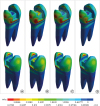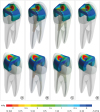1. Popescu SM, Diaconu OA, Scrieciu M, Marinescu IR, Drăghici EC, Truşcă AG, Bănică AC, Vătu M, MercuŢ V. Root fractures: epidemiological, clinical and radiographic aspects. Rom J Morphol Embryol. 2017; 58:501–506.
2. Bastone EB, Freer TJ, McNamara JR. Epidemiology of dental trauma: a review of the literature. Aust Dent J. 2000; 45:2–9.

3. Rho YJ, Namgung C, Jin BH, Lim BS, Cho BH. Longevity of direct restorations in stress-bearing posterior cavities: a retrospective study. Oper Dent. 2013; 38:572–582.

4. Tribst JP, Dal Piva AM, Borges AL, Bottino MA. Simulation of mouthguard use in preventing dental injuries caused by different impacts in sports activities. Sport Sci Health. 2019; 15:85–90.

5. Teixeira ES, Rizzante FA, Ishikiriama SK, Mondelli J, Furuse AY, Mondelli RF, Bombonatti JF. Fracture strength of the remaining dental structure after different cavity preparation designs. Gen Dent. 2016; 64:33–36.
6. Laske M, Opdam NJ, Bronkhorst EM, Braspenning JC, Huysmans MC. Risk factors for dental restoration survival: a practice-based study. J Dent Res. 2019; 98:414–422.

7. Mergulhão VA, de Mendonça LS, de Albuquerque MS, Braz R. Fracture resistance of endodontically treated maxillary premolars restored with different methods. Oper Dent. 2019; 44:E1–E11.

8. Tang W, Wu Y, Smales RJ. Identifying and reducing risks for potential fractures in endodontically treated teeth. J Endod. 2010; 36:609–617.

9. de Andrade GS, Tribst JP, Dal Piva AO, Bottino MA, Borges AL, Valandro LF, Özcan M. A study on stress distribution to cement layer and root dentin for post and cores made of CAD/CAM materials with different elasticity modulus in the absence of ferrule. J Clin Exp Dent. 2019; 11:e1–e8.

10. Dal Piva AM, Tribst JP, Borges AL, Bottino MA, Souza RO. Do mechanical advantages exist in relining fiber posts with composite prior to its cementation? J Adhes Dent. 2018; 20:511–518.
11. da Fonseca GF, de Andrade GS, Dal Piva AM, Tribst JP, Borges AL. Computer-aided design finite element modeling of different approaches to rehabilitate endodontically treated teeth. J Indian Prosthodont Soc. 2018; 18:329–335.

12. Barcellos RR, Correia DP, Farina AP, Mesquita MF, Ferraz CC, Cecchin D. Fracture resistance of endodontically treated teeth restored with intra-radicular post: the effects of post system and dentine thickness. J Biomech. 2013; 46:2572–2577.

13. Ausiello P, Apicella A, Davidson CL, Rengo S. 3D-finite element analyses of cusp movements in a human upper premolar, restored with adhesive resin-based composites. J Biomech. 2001; 34:1269–1277.

14. Srivastava B, Devi NN, Gupta N, Singh R. Comparative evaluation of various temperature changes on stress distribution in class II mesial-occlusal-distal preparation restored with different restorative materials: a finite element analysis. Int J Clin Pediatr Dent. 2018; 11:167–170.

15. Lee MR, Cho BH, Son HH, Um CM, Lee IB. Influence of cavity dimension and restoration methods on the cusp deflection of premolars in composite restoration. Dent Mater. 2007; 23:288–295.

16. Nothdurft FP, Seidel E, Gebhart F, Naumann M, Motter PJ, Pospiech PR. The fracture behavior of premolar teeth with class II cavities restored by both direct composite restorations and endodontic post systems. J Dent. 2008; 36:444–449.

17. Nothdurft FP, Seidel E, Gebhart F, Naumann M, Motter PJ, Pospiech PR. Influence of endodontic posts on the fracture behavior of crowned premolars with Class II cavities. J Dent. 2008; 36:287–293.

18. Hofmann N, Just N, Haller B, Hugo B, Klaiber B. The effect of glass ionomer cement or composite resin bases on restoration of cuspal stiffness of endodontically treated premolars in vitro. Clin Oral Investig. 1998; 2:77–83.

19. Ausiello PP, Ciaramella S, Lanzotti A, Ventre M, Borges AL, Tribst JP, Dal Piva A, Garcia-Godoy F. Mechanical behavior of Class I cavities restored by different material combinations under loading and polymerization shrinkage stress. A 3D-FEA study. Am J Dent. 2019; 32:55–60.
20. Costa VL, Tribst JP, Uemura ES, de Morais DC, Borges AL. Influence of thickness and incisal extension of indirect veneers on the biomechanical behavior of maxillary canine teeth. Restor Dent Endod. 2018; 43:e48.

21. Sousa MP, Tribst JP, de Oliveira Dal Piva AM, Borges AL, de Oliveira S, da Cruz PC. Capacity to maintain placement torque at removal, single load-to-failure, and stress concentration of straight and angled abutments. Int J Periodontics Restorative Dent. 2019; 39:213–218.

22. Costa VL, Tribst JP, Borges AL. Influence of the occlusal contacts in formation of Abfraction Lesions in the upper premolar. Braz Dent Sci. 2017; 20:115–123.

23. Tribst JP, Dal Piva AM, Borges AL. Biomechanical behavior of indirect composite materials: a 3D-FEA study. Braz Dent Sci. 2017; 20:52–57.

24. Ausiello P, Ciaramella S, Martorelli M, Lanzotti A, Gloria A, Watts DC. CAD-FE modeling and analysis of class II restorations incorporating resin-composite, glass ionomer and glass ceramic materials. Dent Mater. 2017; 33:1456–1465.

25. Monteiro JB, Dal Piva AM, Tribst JP, Borges AL, Tango RN. The effect of resection angle on stress distribution after root-end surgery. Iran Endod J. 2018; 13:188–194.
26. Gloria A, Maietta S, Richetta M, Ausiello P, Martorelli M. Metal posts and the effect of material–shape combination on the mechanical behavior of endodontically treated anterior teeth. Metals (Basel). 2019; 9:125.

27. Menezes-Silva R, Velasco SR, Bastos RS, Molina G, Honório HM, Frencken JE, Navarro MF. Randomized clinical trial of class II restoration in permanent teeth comparing ART with composite resin after 12 months. Clin Oral Investig.
28. Kim ME, Park SH. Comparison of premolar cuspal deflection in bulk or in incremental composite restoration methods. Oper Dent. 2011; 36:326–334.

29. Braga S, Oliveira L, Rodrigues RB, Bicalho AA, Novais VR, Armstrong S, Soares CJ. The effects of cavity preparation and composite resin on bond strength and stress distribution using the microtensile bond test. Oper Dent. 2018; 43:81–89.

30. Santos SS, Delbem AC, Moraes JC, Souza JA, Oliveira LQ, Pedrini D. Resin-modified glass ionomer containing calcium glycerophosphate: physico-mechanical properties and enamel demineralization. J Appl Oral Sci. 2019; 27:e20180188.

31. Jones G, Taylor G. Glass ionomer or composite resin for primary molars. Evid Based Dent. 2018; 19:86–87.

32. Wang X, Shu X, Zhang Y, Yang B, Jian Y, Zhao K. Evaluation of fiber posts vs metal posts for restoring severely damaged endodontically treated teeth: a systematic review and meta-analysis. Quintessence Int. 2019; 50:8–20.
33. Elsharkasi MM, Platt JA, Cook NB, Yassen GH, Matis BA. Cuspal deflection in premolar teeth restored with bulk-fill resin-based composite materials. Oper Dent. 2018; 43:E1–E9.

34. Yarmohamadi E, Jahromi PR, Akbarzadeh M. Comparison of cuspal deflection and microleakage of premolar teeth restored with three restorative materials. J Contemp Dent Pract. 2018; 19:684–689.

35. Tribst JP, Kohn BM, de Oliveira Dal Piva AM, Spinola MS, Borges AL, Andreatta Filho OD. Influence of restoration thickness on the stress distribution of ultrathin ceramic onlay rehabilitating canine guidance: a 3D-finite element analysis. Minerva Stomatol. 2019; 68:126–131.

36. Heikkinen TT, Matinlinna JP, Vallittu PK, Lassila LV. Long term water storage deteriorates bonding of composite resin to alumina and zirconia short communication. Open Dent J. 2013; 7:123–125.

37. Ausiello P, Ciaramella S, Fabianelli A, Gloria A, Martorelli M, Lanzotti A, Watts DC. Mechanical behavior of bulk direct composite versus block composite and lithium disilicate indirect Class II restorations by CAD-FEM modeling. Dent Mater. 2017; 33:690–701.












 PDF
PDF Citation
Citation Print
Print




 XML Download
XML Download